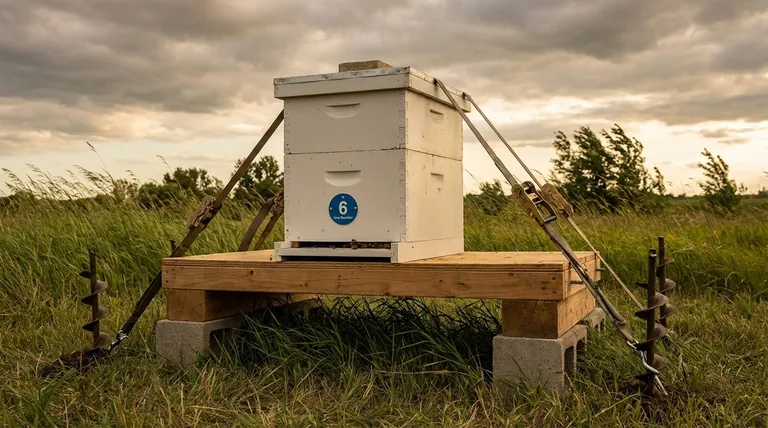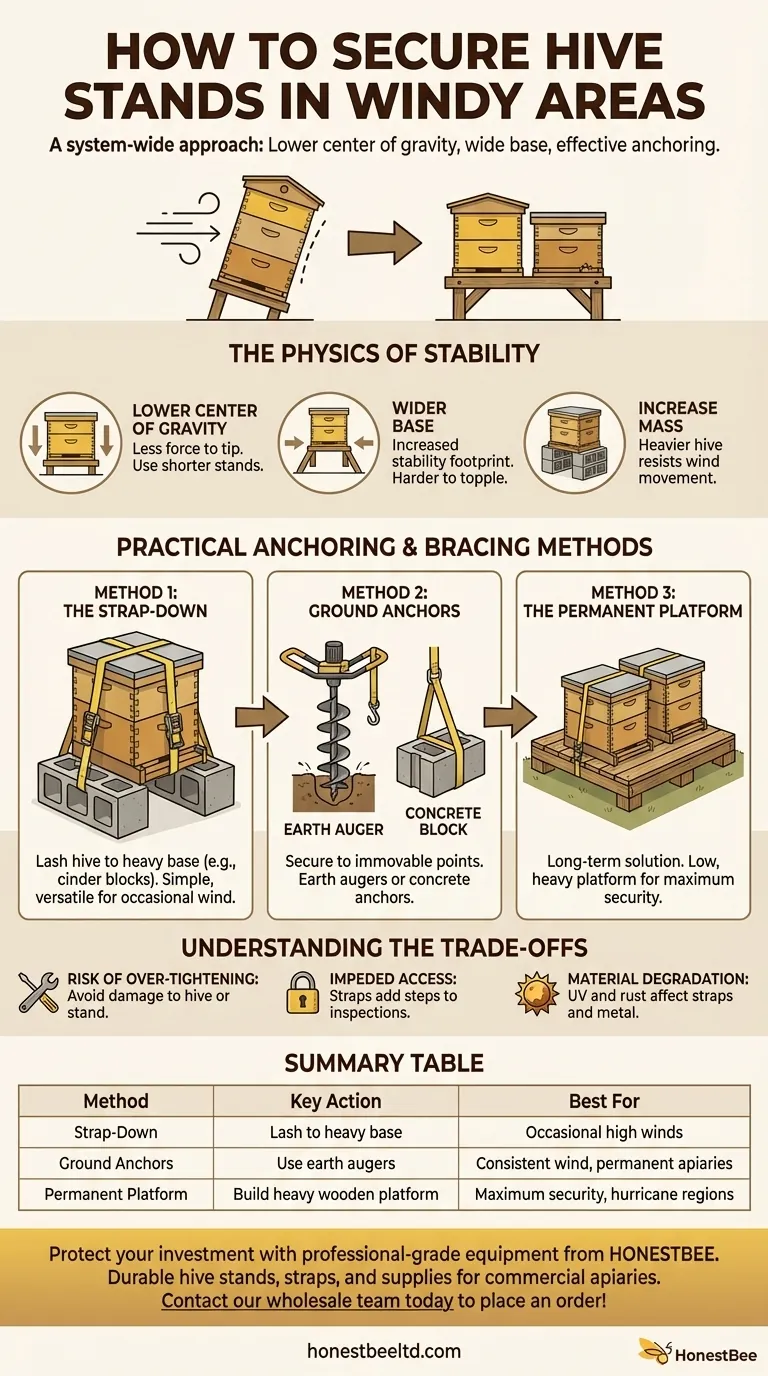To secure a hive stand in a windy area, the most direct method is to physically anchor the entire hive assembly. This is often achieved by using ratchet straps to lash the hive to a heavy base or to anchors driven into the ground. Incorporating a bracing bar beneath the hive can provide a secure point for these straps, preventing them from slipping and ensuring even pressure.
While strapping is a necessary tactic, true hive security in windy conditions depends on a system-wide approach. The most resilient setups combine a low center of gravity, a wide and heavy base, and effective anchoring to the ground.

The Physics of a Stable Hive
Before choosing a method, it is crucial to understand the forces at play. A tall, top-heavy beehive acts like a sail in the wind. Our goal is to counteract the force of the wind by making the hive harder to tip over.
Lowering the Center of Gravity
A lower hive is inherently more stable. The higher the hive's center of gravity, the less force is required to push it past its tipping point. Using shorter stands is the simplest way to improve stability.
Widening the Base of Support
A wider base provides a more stable foundation. Imagine trying to tip over a pyramid versus a tall, thin pole. The stand's feet should extend outward, increasing the footprint on the ground and making it much more difficult to topple.
Increasing Mass
A heavier hive is harder for the wind to move. Using heavy materials for the stand itself or adding weight to the base are effective strategies. This is the principle behind using concrete blocks as hive stands.
Practical Anchoring and Bracing Methods
Based on the principles above, here are the most effective methods for securing your hive, ranging from simple to complex.
Method 1: The Strap-Down
This is the most common and versatile solution. It involves using one or two heavy-duty ratchet straps.
The strap runs vertically over the top of the hive lid, down the sides, and secures to an anchor point. This method holds all the hive components (lid, supers, brood boxes, and bottom board) together while also securing them to the stand and the ground.
Method 2: Ground Anchors
Strapping a hive is useless if the anchor itself can move. The straps must be secured to an immovable object.
- Earth Augers (Mobile Home Anchors): These are large, corkscrew-like anchors that you twist deep into the ground. They provide an exceptionally strong attachment point for straps in soil.
- Concrete Blocks: Running straps around one or two heavy concrete blocks (like cinder blocks) on which the stand rests adds significant mass and a secure point of contact.
Method 3: The Permanent Platform
For a long-term apiary, building a low-profile, heavy-duty platform is an excellent investment. This can be a simple frame made of 4x4 lumber and decked with 2x6 boards, resting directly on level ground or on concrete blocks. The hives can then be strapped directly to the platform itself.
Understanding the Trade-offs
Securing your hive involves compromises. Being aware of them allows you to make the best choice for your situation.
Risk of Over-Tightening
Ratchet straps can exert immense force. Overtightening can crack the hive lid, damage the wooden boxes, or even crush the stand. The goal is to make the strap taut and firm, not to apply maximum pressure.
Impeded Access for Inspections
Straps running over the hive must be removed and re-secured for every inspection. This adds an extra step to your beekeeping routine. Plan your anchoring system to make this process as quick and easy as possible.
Material Degradation
Straps left in the sun will degrade from UV exposure over time and should be inspected seasonally for fraying or brittleness. Metal components can rust, and wooden stands require proper treatment to resist rot, especially at ground contact points.
How to Apply This to Your Apiary
Your ideal solution depends on your specific conditions and goals.
- If your primary focus is a simple, low-cost solution for occasional high winds: Use ratchet straps secured around two heavy cinder blocks placed under your existing hive stand.
- If your primary focus is setting up a permanent apiary in a consistently windy location: Install earth augers on either side of the hive and use straps to create a robust, long-term anchoring system.
- If your primary focus is maximum security in a hurricane-prone region: Combine all methods by building a low, heavy wooden platform, placing hives on it, and using straps attached to earth augers as the final line of defense.
Ultimately, proactively securing your hives against the wind is the best insurance for the health of your colony and the success of your apiary.
Summary Table:
| Method | Key Action | Best For |
|---|---|---|
| Strap-Down | Use ratchet straps to lash hive to a heavy base. | Simple, versatile protection for occasional high winds. |
| Ground Anchors | Screw earth augers into the soil for a solid anchor point. | Permanent apiaries in consistently windy locations. |
| Permanent Platform | Build a low, heavy-duty wooden platform for the hive. | Maximum security in hurricane-prone regions. |
Protect your investment and ensure your colony's safety with professional-grade equipment from HONESTBEE. We supply durable, heavy-duty hive stands, ratchet straps, and other essential beekeeping supplies designed specifically for the needs of commercial apiaries and equipment distributors. Let us help you build a more resilient and productive apiary. Contact our wholesale team today to discuss your needs and place an order!
Visual Guide

Related Products
- Professional Engraved Round Hive Number Tags for Beekeeping
- Metal Hive Feet Bee Hive Stand for Ant Protection
- Plastic Bee Hive Stand for Beekeeping
- Metal Bee Hive Stand Bee Box Stand for Beekeeping
- Professional Drop-Style Hive Handles for Beekeeping
People Also Ask
- Why are Posca pens commonly used for marking queen bees? The Safest, Most Durable Method for Beekeepers
- What is the purpose of a hive stand, and why is it beneficial? Elevate Your Hive for Colony Health and Beekeeper Comfort
- What is the best height for a hive stand? Optimize for Pest Control and Beekeeper Ergonomics
- Why should beekeepers consider using hive stands? Protect Your Hives and Your Back
- How should a Posca pen be prepared for queen marking? Ensure a Safe, Precise Mark Every Time



















